eSIM Evolution: Integration Across Mobile Devices Over Time
The eSIM revolution is here and you don't want to miss it. Read all about the eSIM and how it has evolved through time!
With the advent and evolution of eSIM card (embedded Subscriber Identity Module) technology, the landscape of mobile communication has shifted dramatically. Smartphones with in-built eSIMs allow consumers to switch carriers and activate services remotely. All this, without having to physically switch a SIM card. As the benefits of the eSIM become common knowledge, so do customer awareness and reception.
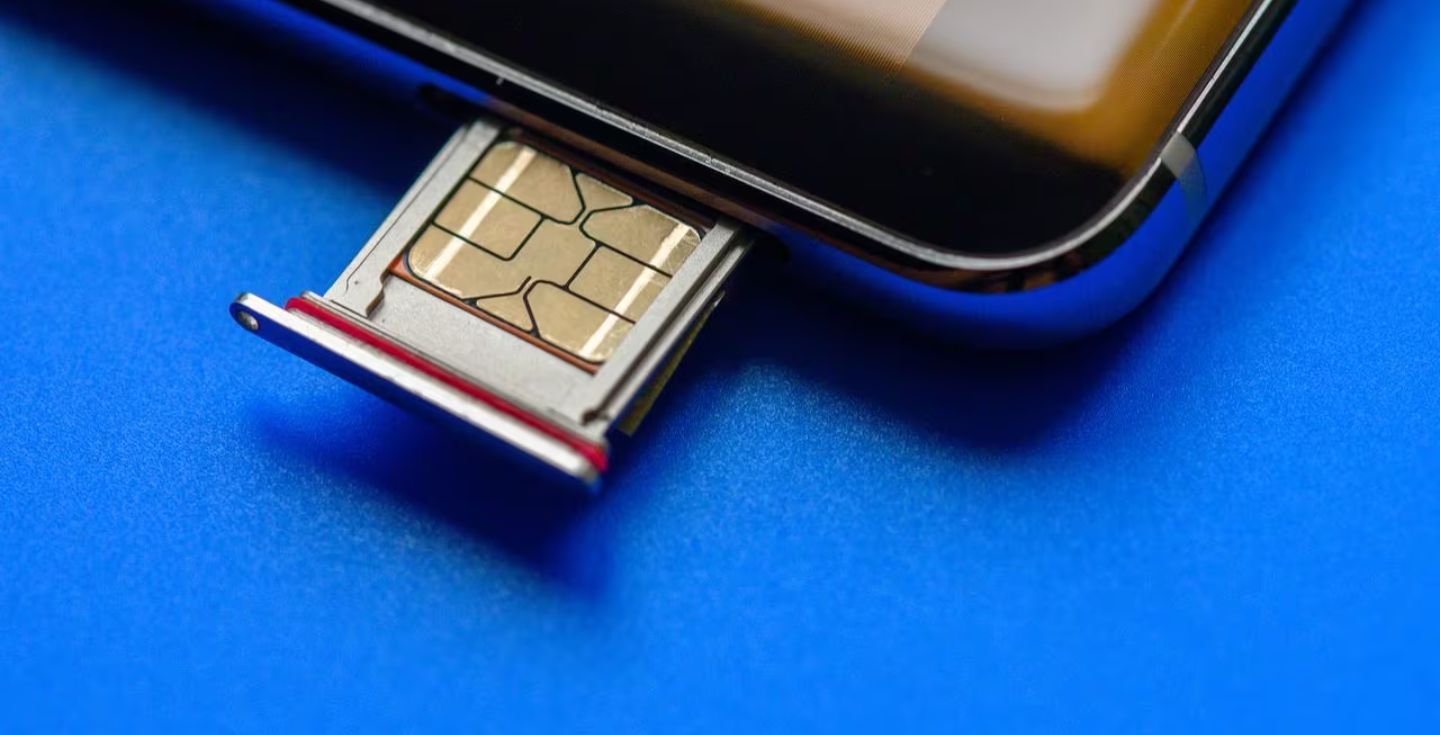


 +1M
+1M
With Holafly, you save +30% compared to roaming fees
Plans that may interest you
The Development of eSIM Systems
Although the notion of embedded subscriber identity modules (eSIMs) developed in the early 2010s, it did not gain substantial popularity until major tech companies began integrating it into their products in 2016 and 2017. The idea behind eSIM was to allow for easier carrier switching and better international connectivity, and it has seen evolution ever since. You can also learn more about what eSIM is.
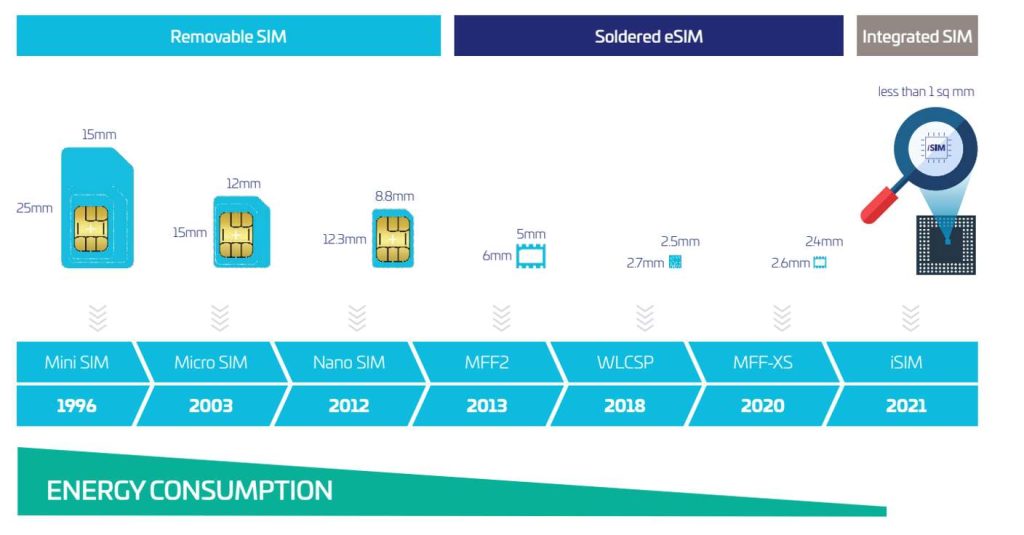
SIMs have not only been reduced in size to save space on a phone, but they have also drastically reduced energy consumption. eSIMs also provide additional security to keep your information and details safe from hackers. Thanks to the eSIM evolution and the fact that we’re talking about an intangible product, it’s much more difficult to steal that information given that PII (Personal Identifiable Information) is required to switch an eSIM from one carrier to another (thefastmode).
eSIM-Enabled Smartphones That You Need to Know About
Popular cellphone brands have been implementing the eSIM from the factory for some time now. As a pioneer, Google has also driven other manufacturers to implement digital SIMs in their devices.
Google Pixel 2 (2017): The Google Pixel 2 was one of the first phones to use embedded SIM cards. No physical SIM card was required for activation of carrier services.
iPhone XS (2018): With the release of the iPhone XS, Apple included eSIM functionality. The smartphone industry quickly adopted eSIM technology as a result of Apple’s influence, signaling a significant shift.
Samsung Galaxy S20 (2020): Samsung eliminated the need for consumers to carry around physical SIM cards by including eSIM technology in its Galaxy S20 line of smartphones.
Google Pixel 5 (2020): The Pixel 5 features Google’s continuing support of eSIM technology by including it as standard.
Apple iPhone 12 (2020): Apple has made eSIM compatibility a common feature across all of its iPhone 12 models, expanding on its previous deployment.
OnePlus 8T (2020): With the release of the OnePlus 8T, the company has joined the eSIM movement, meeting the rising need for carrier activation without physically being present.
(Get the full list here!)
Revolutionary iPhone 14 and rumored iPhone 15
The iPhone 14 launched in September 2022 and even though the international version launched with eSIM and nano-sim capabilities, the US version launched with only an eSIM option. There’s no slot to insert a SIM chip. This gives us insight into the new trend that cellular manufacturers will most likely begin to pick up in the coming years.
On the other hand, the iPhone 15 is soon to be launched, and there are numerous expectations regarding Apple’s upcoming flagship phone. One of the rumors that interests us is whether the new iPhone will include a SIM slot. Following the iPhone 14’s example, perhaps the international version will and the US version won’t. If no version includes the SIM slot, then it’s a message to the world that we must begin to globally adopt and include it at a faster rate.
Future Projections for Mobile use
The traditional SIM card still has the upper hand when it comes to market share. However, if there’s one thing we can say for certain, it’s that eSIM-enabled cellphones will eventually take over the landscape. The number of devices with eSIM integration was 1.2 billion in 2021. This number is expected to rise by more than 3 billion by 2025. As per smartphones, there are more than 900 million eSIMs active, according to Mobiliseglobal.
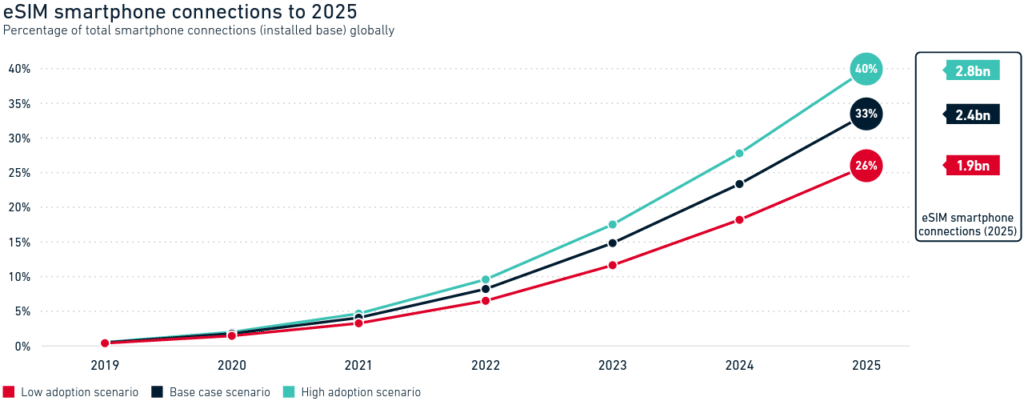
As per GSMA Intelligence, in their eSIM: State of the consumer market and the road ahead report from March 2021, there are projected to be around 2.8 billion eSIM enabled smartphones under a high adoption scenario. Additionally, the adoption and availability of eSIM services for smartphones have been increasing.
We have analyzed the information taken from several sources to compile the trend of eSIM vs. SIM card connections globally. If we take this scenario and adjust it to the total mobile connections in the world, we can see that the digital SIM is slowly making its way to becoming the standard. More and more operators are connecting eSIM-capable phones. These integrate both the regular SIM card and the eSIM as a dual-SIM phone.
In 2020, there were over 5 billion SIM phone connections and just over 100 million digital SIM phone connections. Now, in 2023, there are over 5.5 billion SIM phone connections and more than one billion eSIM or dual SIM (SIM & eSIM) connections. The gap between physical and digital chips is slowly closing.
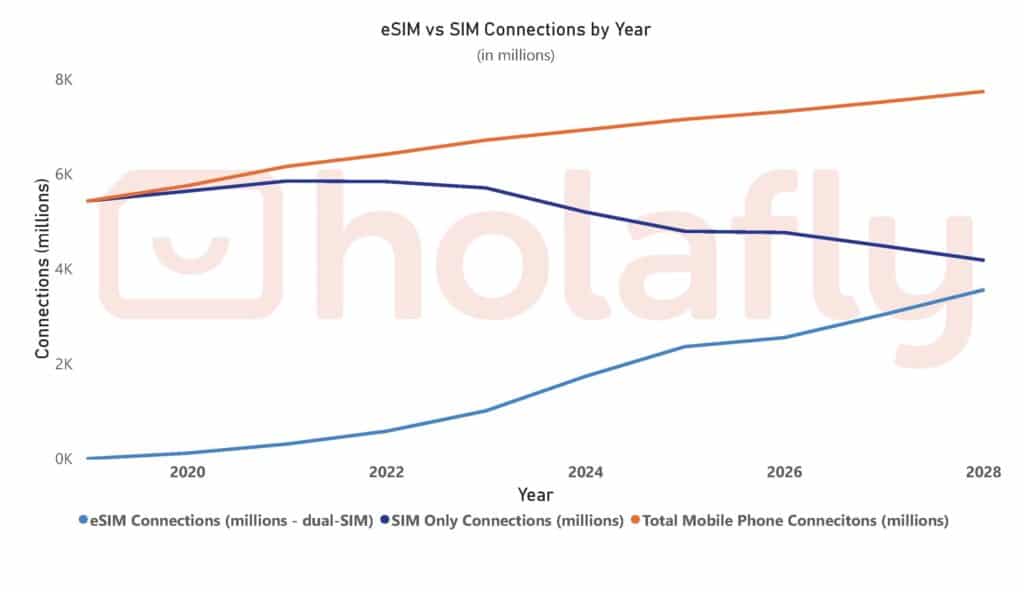
Taking information from Statista and GSMA Intelligence, we generated a future projection on the market share of eSIM versus SIM card connections for 2028. As observed in the chart above, the gap is slowly closing, and eSIM-capable phone connections are steadily increasing while only-SIM phone connections are diminishing. This indicates that numerous manufacturers, providers, and customers are accepting and implementing the eSIM.
eSIM Technology Is Being Adopted By Carriers.
MNOs or Mobile Network Operators, are continuing to implement eSIM technology within their available services for a better connected world. However, there’s still a long way to go. As stated in the March 2021 GSMA report, at the end of 2020, 69 countries had already launched eSIM services for smartphones, which translated to a total of 175 domestic operators. 90% of operators plan to offer eSIM services by 2025.
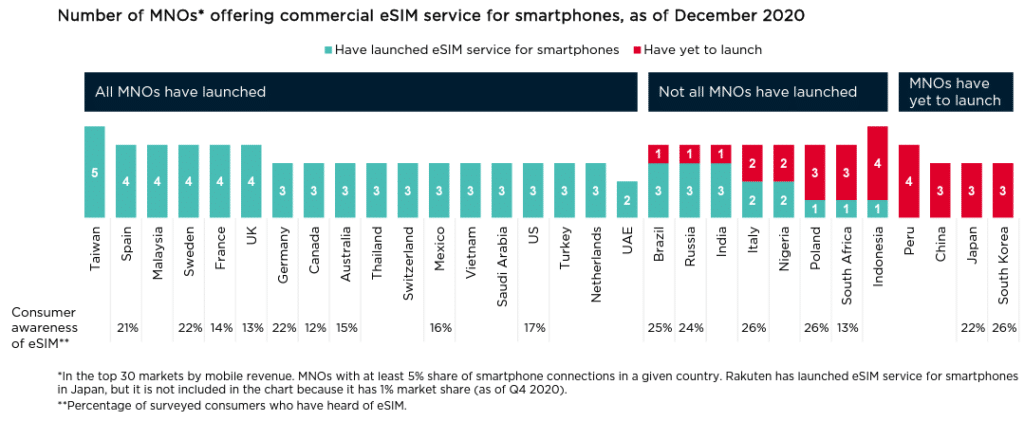
There are popular carriers that have adopted eSIM technology, and several have different activation methods. This push also gives eSIM momentum to become the next top option for consumers and even travelers. Check out the full list of operators that offer eSIM services, updated for March 2023.
Makers are pushing for eSIM adoption
- Apple: Apple’s contributions to the spread of eSIM technology were crucial. Other companies followed Apple’s lead and used it in their products after seeing it implemented in multiple iPhone versions.
- Google: Google’s Pixel portfolio was essential in expanding the use of eSIMs because of the company’s advocacy for the technology.
- Samsung: Samsung’s adoption of eSIM in its top-tier products has helped spread the technology even further.
Many global manufacturers are implementing the virtual SIM chip into their flagships and other models. Let’s take a more profound look at how many phones the most popular and recognized cellphone makers have.
| Manufacturer | Number of eSIM-compatible Mobiles |
| Apple | 19 |
| Samsung | 22 |
| Xiaomi | 4 |
| Motorola | 6 |
| 19 | |
| Vivo | 2* |
| Huawei | 3 |
* V29 Lite 5G (support only in Europe).
Customer Awareness
Even with operators and manufacturers pushing for the penetration of eSIM technology in smartphones and cellular services, only around 20% of consumers are aware of this evolution, according to GSMA Intelligence.
It’s crucial for carriers and cellphone makers to promote the benefits and advantages of using an eSIM, such as increased flexibility, security, and a more positive environmental impact. Additionally, a digital SIM is much more accessible thanks to digital channels and reduces sign up times. One tactic could come from the larger operators worldwide. According to a GSMA survey, operators with over 75 million subscribers tend to have more faith in the eSIM.

The Prospects for eSIM Innovation
More and more cellphone manufacturers and service providers are likely to start using eSIMs as the technology continues to gain popularity. eSIM is appealing to consumers and the mobile industry due to its remote activation, adaptability, and decreased dependency on physical cards. Nonetheless, new strategies have to be implemented to persuade consumers to approach and integrate this new technology into their lifestyle.
Let’s take a look at some of the reasons why consumers seem not to have an interest in the eSIM.

According to findings, GSMA 2022 reports that 23% of consumers state that they’re happy with the traditional removable SIM card. This may be because they do not know specifically how they benefit from the digital SIM’s security, flexibility, and convenience. Another 16% state they’re just not interested in using an eSIM or don’t see the benefits. This represents a huge opportunity for domestic and international MNO’s and MVNO’s to show customers and consumers how easy it is to use an eSIM, the savings it may bring, and all the other advantages that this evolution provides.
Advantages and Disadvantages
Embedded Subscriber Identity Module (eSIM) technology has both positive and negative aspects, depending on the context. The benefits and drawbacks of eSIM are listed below in bullet points.
Pros
- Save Space: Given that the eSIM is intangible, this helps manufacturers save space on their devices.
- Multiple Profiles: Several eSIM profiles can be stored on a phone, so there’s no SIM chip switching.
- Environmentally friendly: Since it minimizes the need for, and thus the waste of, real SIM cards.
- Dual-SIM: You can use both your eSIM and your regular SIM card, which makes your phone dual-sim.
- Easy activation: You can easily buy and install your eSIM from your computer with a QR code.
Cons
- Limited support: One major drawback is that eSIM technology isn’t universally supported, especially among older smartphones.
- Network compatibility: This is another issue, as eSIM might not be compatible with all cell carriers or in all regions.
eSIM and SIM card Comparison
Let’s take a look at a comparison chart between traditional SIM cards and the eSIM across various aspects:
| Aspect | Physical SIM | eSIM |
|---|---|---|
| Form Factor | Physical card (plastic) | Embedded chip in device |
| Activation | Requires to be physically inserted | Remote activation |
| Profile Switching | Requires physical swapping | Can switch profiles remotely |
| Space | Takes up physical space | Saves space, especially in small devices |
| Network Compatibility | Works with any unlocked device | The device must support eSIM and carrier support required |
| International Travel | Requires swapping SIM cards | Easily switch carriers |
| Environmental Impact | Consumes plastic cards | Reduces plastic waste |
| Security | Susceptible to physical theft or cloning | More secure and harder to tamper with |
| Privacy Concerns | Data stored on physical card | Digital storage and the potential for remote deactivation |
| Device Support | Widely supported in older devices | Growing support, especially in newer devices |
| Transition Period | Well-established technology | Still evolving and may have limited support |
This is just a short summary of the major differences between an eSIM vs SIM card.
When you travel with an international eSIM, you get many benefits besides just the data plan and connection. To start off with, you can easily switch eSIMs when needed or simply use a regional or global digital SIM. Forget about the hassle of switching chips and risking losing your SIM cards. Avoid excessive roaming charges or outrageous charges and fees with Pocket WiFi. With the digital SIM, you get just one flat fee with all the services included. On the other hand, don’t waste time waiting for packages or deliveries that may be delayed and might not even arrive by the time you leave.
Next Steps
The introduction of eSIM technology has revolutionized how we think about mobile data connectivity. The widespread acceptance of eSIM by both major carriers and manufacturers follows its early adoption by IT heavyweights like Google and Apple. As eSIM becomes the industry standard and streamlines user experiences, it is likely to shape future mobile communication.
As for the future, manufacturers will have to dive deeper into the implementation of eSIM on new and upcoming smartphone models. Likewise, carriers must take the lead in advertising the potential benefits to customers in their personal and professional lives. This sparks curiosity and interest on behalf of clients and customers, but helping them understand is key. As more people comprehend and adapt to this changing world of communication, the more seamless it becomes to remain connected, no matter where you are.
There are already talks about the future of the digital SIM, referred to as the iSIM as the next milestone in this continuous evolution of communication. Even though this is just preliminary research and projects, be a step ahead and take a look at the differences and similarities among the eSIM and the iSIM.






































 Pay
Pay  Language
Language  Currency
Currency 


















 No results found
No results found







